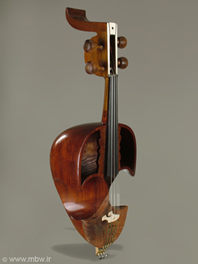
Ney (reed), probably the oldest pitched instrument known to man, is a wind instrument made from a piece of hollow cane or reed that has been played continuously for thousands of years. It is a forerunner of the modern flute and although common throughout the Near-east, the Iranian technique is probably the most versatile, using both the low breathy register and the sharp higher register (held between the teeth).
The pitch of the ney varies depending on the region and the finger arrangement. A highly skilled ney player can reach more than three octaves, though it is more common to have several “helper” neys to cover different pitch ranges or to facilitate playing technical passages.
Neys come in all sizes, in a range limited only by the reach of the fingers (for big neys) and the thickness of fingers (for small neys). Naturally, long neys are low pitched, and short neys are high pitched.
The Persian Ney is an oblique rim blown reed flute, held with both hands and with five finger holes in front and one thumb hole in the back. It is one of the principle instruments of Traditional Persian Music and has a range of two and a half octaves. The upper end is usually covered by a short brass cylinder which is anchored in the tiny space between the upper incisive of the player.
Sound is produced when a stream of air is directed by the tongue toward the opening of the instrument. In this way, sound is produced behind the upper teeth, inside the mouth, which gives the Iranian Ney a distinct sound.



















